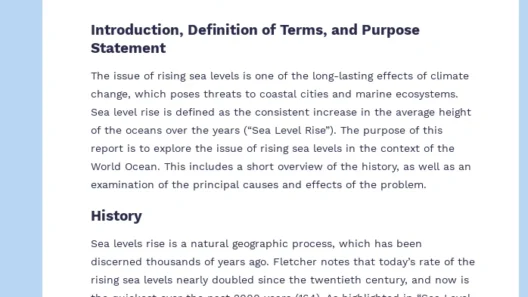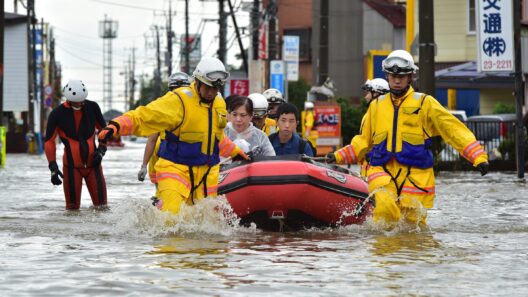As oceans envelop the shores like a slow, relentless tide inching upwards, a question looms large: Is sea level actually rising? The phenomenon of rising sea levels is more than an abstract concept; it is an alarming reality that underscores the fragility of coastal ecosystems and human settlements alike. This article navigates through the intricate evidence surrounding rising sea levels, examining scientific studies, historical data, and the consequential effects on our planet.
To embark on this exploration, it is essential to understand the mechanisms that underpin sea level rise. Climatologists and oceanographers have identified two primary contributors to this global phenomenon—thermal expansion and glacial melting. As global temperatures escalate, the oceans grow warmer, causing water to expand. Concurrently, the melting of polar ice sheets and glaciers contributes an influx of freshwater into the marine environment. This dual action produces an unmistakable conclusion: the world’s oceans are indeed rising, albeit at varying rates globally.
Historical Context: The Geological Perspective
Sea level change is not a novel occurrence; it has haunted our planet for eons. During the last Ice Age, sea levels plummeted as moisture was sequestered in vast ice sheets. Conversely, as these glaciers retreated, sea levels surged. Today, however, we find ourselves in a unique juncture characterized by human-induced climate change. The Intergovernmental Panel on Climate Change (IPCC) reports an alarming average increase of approximately 3.3 millimeters per year since the 1990s. Framed against historical patterns, this contemporary acceleration is unprecedented. What remains intriguing is the interplay of natural and anthropogenic factors that govern these shifts.
Geological records serve as time capsules, providing insight into how sea levels have ebbed and flowed over millennia. Fossilized marine life, sediment cores, and ancient shorelines reveal a tapestry of ongoing change, yet nothing in this history might prepare us for the unprecedented pace of change we witness today. This geological perspective amplifies the chilling gravity of current trends, compelling us to ponder the ramifications for future generations.
The Scientific Array: Measuring the Rise
Armed with robust technology, researchers scrutinize sea level changes through a constellation of tools and techniques, including satellite altimetry, tide gauges, and computer models. These instruments offer a multi-faceted view of sea level dynamics. Evidence reveals that sea levels are not rising uniformly across the globe. Phenomena like ocean currents and gravitational effects create regional disparities, complicating the narrative of rising oceans. For instance, locations such as the Pacific Islands and parts of the Eastern United States experience far greater increases than others. This uneven rise presents unique challenges for coastal communities.
Moreover, the consequences of rising sea levels transcend simple numerical changes. Coastal erosion becomes more acute, threatening ecosystems and lodging them in a precarious state. Saltwater intrusion threatens freshwater aquifers, exacerbating water scarcity issues in various regions. As a result, agricultural lifelines become compromised, giving rise to food security crises. The broader impacts ripple through economics, health, and regional stability, painting a grim portrait of what the future may hold if action is not taken to mitigate climate change.
Climate Impact: A Ripple Effect
The environmental ramifications of rising sea levels are deep and transformative. Coastal wetlands, which act as natural buffers against storm surges, are progressively diminishing. Cities like Miami, New Orleans, and Venice find themselves in a race against time, desperately seeking solutions as inundation becomes a tangible threat. Increasingly frequent and severe storms are a direct consequence of rising sea levels, posing risks not only to infrastructure but also to human life. The metaphorical groundwork laid by climate science resounds loudly: oceans are reclaiming their rightful territory, and humanity stands on the precipice of an ecological reckoning.
Empirical studies highlight dramatic shifts in marine biodiversity, as species migrate in response to changing habitats. Coral reefs, the vibrant underwater gardens of our oceans, suffer tremendously from the combined stress of rising temperatures and acidity levels. This harmonic structure of marine ecosystems teeters on the brink of collapse, heralding a future with diminished biodiversity and altered ecosystems. Each microscopic shift in this delicate balance carries consequences that stretch into realms beyond the ocean’s surface—impacting fish populations, the fishing industry, and the communities that depend on them.
Adaptation and Mitigation: Collective Responsibility
Despite the daunting challenge presented by rising sea levels, the discourse surrounding adaptation and mitigation offers a glimmer of hope. Communities and governments are increasingly recognizing the need for comprehensive strategies that address both immediate and long-term challenges. Resilient infrastructure, coastal restoration projects, and sustainable land use policies are pivotal steps toward countering the forecasted impacts. International coalitions and agreements bolster collective action, aiming to curb greenhouse gas emissions and limit temperature increases. All these endeavors necessitate far-reaching contributions from individuals and entities alike.
Rising sea levels stand as both a harbinger of impending change and a call to action for humanity. The evidence is compelling; the stakes are existential. As we navigate the complexities and ramifications of this phenomenon, it becomes evident that turning a blind eye is no longer an option. Every drop of water that inches towards our shorelines carries with it the weight of our collective future. Embracing this reality can ignite the spirit of innovation and cooperation necessary to forge a sustainable path forward, ultimately laying the groundwork for a more resilient planet.








